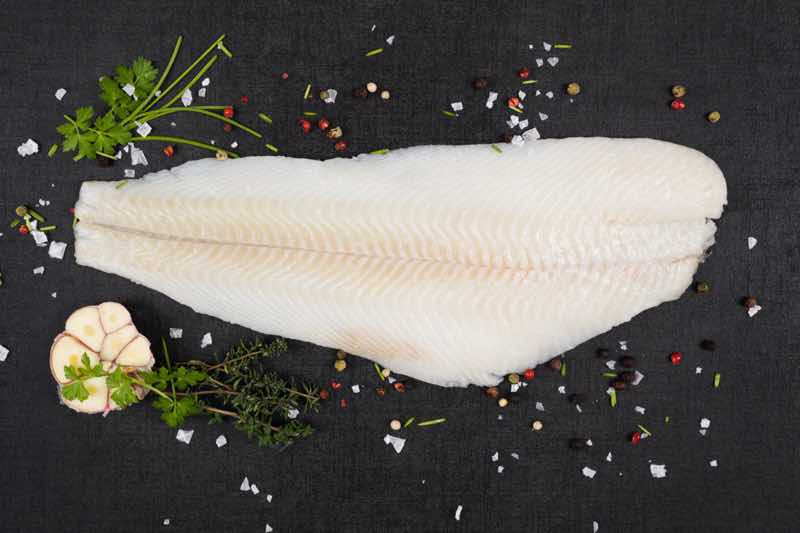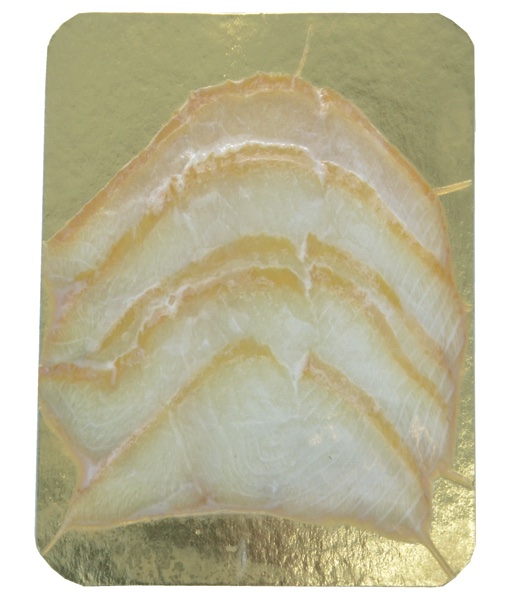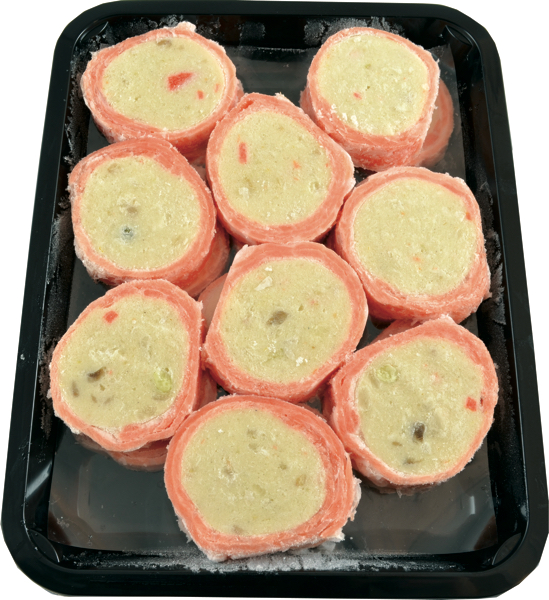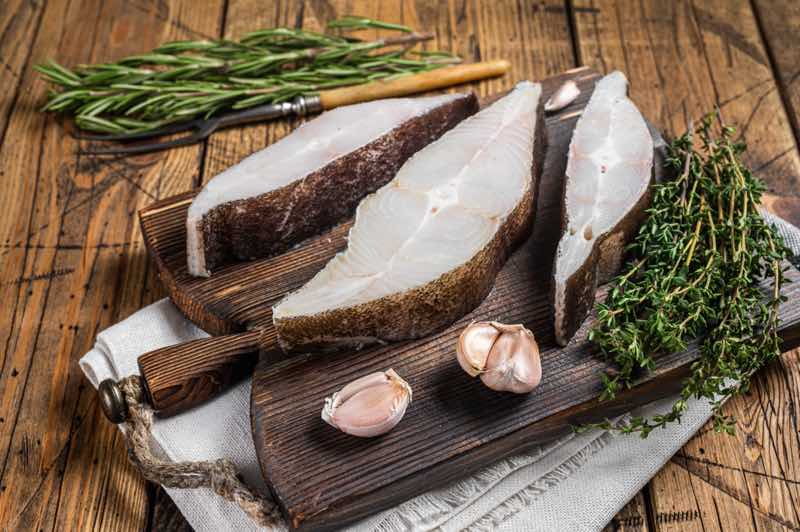Nederlands
English
Deutsch
Français
Halibut is an exclusive fish known for its delicate flavour and versatile use in cuisine. Its impressive size and unique features make halibut a popular choice for true connoisseurs.
If you are a buyer of halibut, it is important to know what to look out for when buying fresh and/or smoked halibut. What are the differences? What are our customers’ most popular choices? What are the differences between halibut, turbot and brill? This article addresses these topics and more in detail so that you are well-informed about all the possibilities with our halibut.
Halibut is a ray-finned fish belonging to the plaice family. This popular flatfish can grow considerably larger than most other fish species. A wild halibut can grow to a length of almost five metres and weigh more than 300 kilograms.
However, the halibut commonly bought and sold are smaller in size, usually between four and 20 kilograms. The fish has a flat body with a white underbelly. The top is dark and covered with tiny scales. Halibut also has a distinctive side mouth with sharp teeth.

Like plaice and turbot – and other flatfish – halibut has two eyes on one side. When lying flat on the bottom of the sea, the halibut always lies with its eyes facing upwards. Unlike plaice and other flatfish, a halibut’s mouth is very large. The halibut’s diet also consists mainly of animal-based food. Adult halibut are true predators and are less dependent on the sea bed than other flatfish.
Halibut has the unique feature of changing colour to suit its environment. This adaptability helps it camouflage itself on the seabed − from a dark colour with spots in deeper waters to a lighter shade in shallower areas. Another unique feature of the halibut is its impressive swimming power. Despite its flat body, the halibut reaches speeds of up to 25 kilometres per hour.
Although halibut, turbot and brill are all flatfish, they have some distinct differences. Halibut belongs to the Plaice family, while turbot and brill belong to the Turbots family. Unlike halibut, turbot do not grow very large: the turbot grows to a maximum length of one metre and weighs a maximum of 25 kilograms. Quite a difference!
Turbot and brill are more similar in appearance than halibut. Turbot has no scales. It has a coarse skin with round lumps. This fish has a slightly more rounded shape than brill. Both halibut and brill have scales and a more elongated body. In terms of taste and texture, halibut has a milder flavour and softer texture than turbot and brill; these both have a firmer texture. Although these three flatfish species differ in taste, they can often be used as substitutes for each other in recipes, depending on availability and personal preferences.
Aside from their names, halibut and turbot, which make it sound like the fish belong to the same family, they do not have much else in common. Turbot and brill, on the other hand, do. If you see a fresh turbot and a fresh brill at the fish market, you will hardly notice any difference between the two fish at first glance. Be sure to take a closer look.
Halibut is very popular in the kitchen for its delicate flavour – with a somewhat sweet undertone – and versatility. The meat has a firm but tender texture. The taste of halibut is often described as subtle and buttery. It is a versatile fish that combines well with various herbs and sauces. Because its meat is very tender, halibut is a popular choice for many culinary dishes.
Halibut can be prepared in various ways, such as frying, grilling, steaming, poaching or smoking. The fish’s firm structure lends itself to all these different preparation methods. Smoked halibut fillet is one of Mooijer-Volendam’s most popular halibut products. Our fresh halibut fillets are first salted and then cold-smoked. The smoking process adds a unique, flavourful dimension to the fish: tender and smoky.

Smoked halibut fillet is often served as an appetiser, on its own or as part of a fish platter or fish cocktail. The smoked fish pieces can also be used as an ingredient in various dishes, such as salads, pastas or sandwiches. Incidentally, the delicate slices also make halibut an excellent choice for topping crackers or toast at a cocktail party.
Another halibut product we definitely want to bring to your attention is our halibut/salmon paté rolls. These paté rolls are extremely popular with our customers. The paté is made from cooked halibut, celery and whipped cream, with a thin slice of smoked salmon wrapped around the roll. Salty and creamy, a delicious combination!

The halibut/salmon paté rolls are delicious on bread or toast but can also be used in starters and main course dishes, for example, baked in puff pastry.
Greenland halibut – also known as Black halibut – is a close relative of the Atlantic halibut, but the two fish are not identical. Atlantic halibut (Hippoglossus hippoglossus) and Black halibut (Reinhardtius hippoglossoides) differ in scientific classification, appearance, habitat and distribution. For example, Black halibut can grow up to 100 cm and weigh much less than Atlantic halibut.
Atlantic halibut are found in the northern parts of the Atlantic Ocean, from the North Atlantic coasts to the Arctic Ocean. Black halibut, on the other hand, is found in northern parts of the Pacific Ocean, extending from Alaska to Siberia and Japan.
Although the flavour of Black halibut is similar to that of the Atlantic halibut, it has a slightly stronger taste, depending on individual factors such as habitat and diet. Both fish have virtually the same structure.

Black halibut is a popular halibut product at Mooijer-Volendam. Thus, at Mooijer-Volendam, we sell Black halibut steaks, black halibut tails and black halibut fillets. These Black halibut products are cold-smoked and are mainly eaten at room temperature.
Halibut is available all year round, but the best fishing periods are usually in autumn and winter when the fish is at its best in terms of flavour and texture. Halibut often migrate over long distances. They can travel thousands of kilometres between their feeding and spawning grounds. These migrations contribute to their ecological importance and distribution.
The halibut population is relatively stable and well-managed to avoid overfishing. Halibut are mainly caught in the northwest and northeast Atlantic. These areas are known for their abundant halibut population. Along the Dutch coast, this fish is extremely rare.
The IUCN status of halibut is near threatened. So when buying halibut, it is important to pay attention to sustainability aspects. Choose halibut that is caught with sustainable fishing methods and has been certified with, for example, the MSC label. This guarantees that the fish has been caught in a responsible and environmentally friendly way.
Black halibut is generally a sustainable choice, especially in the North Pacific and along the coasts of Alaska. Fishing is carefully regulated in this area, and quotas are set to prevent overfishing and protect the population.
If you are looking for high-quality halibut, then fish wholesaler Mooijer-Volendam is the right choice. Mooijer-Volendam is a reliable supplier of fish products for various types of clients, such as the catering industry, fishmongers and retailers.
Mooijer-Volendam’s product range includes a wide variety of halibut products, from smoked halibut paté rolls to black halibut. All halibut products carry the required quality certificates to ensure traceability and sustainability. Are you a buyer looking for fresh halibut? We can supply fresh halibut on pre-order.
Discover Mooijer-Volendam’s full range of halibut products
Are you curious about Mooijer-Volendam’s full range of halibut products? At Mooijer-Volendam, you will find a wide selection of high-quality halibut. Take a look and discover the possibility of adding halibut to your menu.